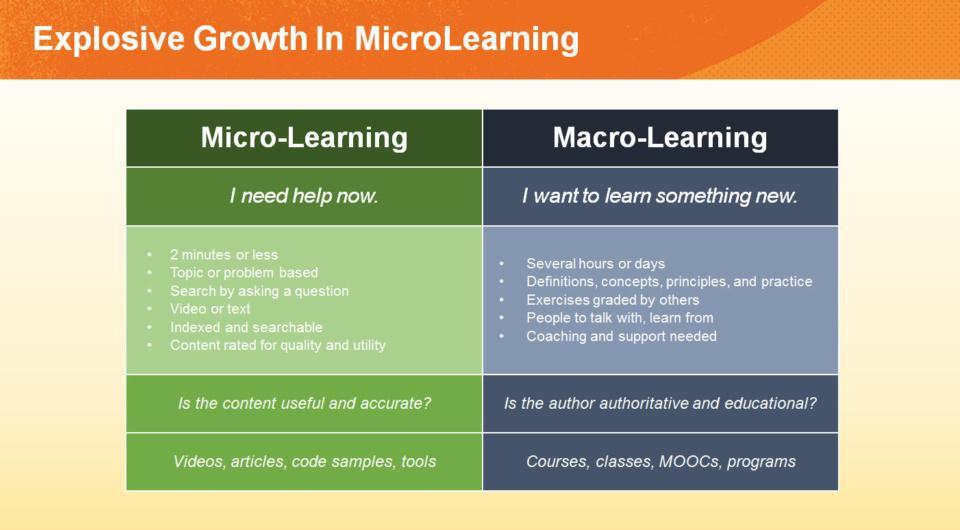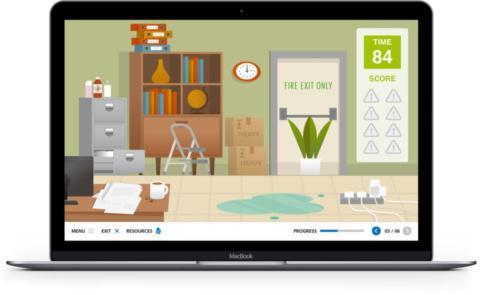Does microlearning replace macrolearning?

Learning interventions can be divided into two main types, micro and macro. They solve different problems. Which should you use to meet your business needs?
Josh Bersin’s recent essay on the disruption of digital learning offers a definition of micro and macro learning that’s useful when you’re developing a learning strategy.

Table by Josh bersin
Macro learning is a formal learning intervention, a self-contained learning event that teaches one subject or area. Want to learn all about using Microsoft Excel for data analysis? Take a Massive Open Online Course (MOOC).
Micro learning presents knowledge that’s required to quickly solve a problem. Need to highlight the duplicates in your Excel spreadsheet? Watch a short clip on YouTube.
The micro/macro mix
Where should we use each type of learning intervention? What kind of mix should we have to get the most benefit from each approach?
Josh Bersin also lays out a graph showing that micro and macro learning are applied at different parts of a learner’s career path. When someone’s new on the job they need macro learning to get up to speed with the big subjects that will affect them. As they progress they use micro learning to pick up ‘just-in-time’ knowledge to solve immediate problems before their learning pace dips and requires another macro intervention.
It’s a useful way to highlight the role of the different types of solution, but it doesn’t tell the whole story. There are many learning opportunities that would benefit from a mix of micro and macro learning.
Recently, the term microlearning has evolved; true microlearning now involves much more than simply breaking down content into small pieces. It can be applied as part of a larger, macro intervention, or on its own.
Start at the beginning
As a Learning & Development professional, you’re given a problem to solve or an objective to reach. We’re going to look at a learner-focused approach to choosing between micro and macro learning solutions.
Talking to learners, managers and subject matter experts will help identify the best approach to take. Creating detailed learner profiles will make it easier to get the right mix for your strategy.
Macro can be the best option
When you need to upskill many learners on a company-wide subject you’re going to need a macro element in your programme. Some areas that often require a macro learning solution as part of the mix are:
Onboarding
Compliance
Change and transformation
Corporate Social Responsibility (CSR)
Onboarding new starters involves delivering lots of new information to a wide variety of roles. Many organisations choose to deliver part of this induction training digitally to allow greater consistency and speed of delivery.
Compliance training will usually be delivered to many workers at once, and there’s a need for tracking completion.
Southern Health delivered compliance with a macro programme
When Southern Health NHS Foundation Trust needed to provide 13 different compliance courses to 7,500 clinical staff at more than 230 sites a macro digital learning solution was the best option.
There are £1.5 million in savings projected over 5 years compared to the traditional face to face training that the suite of digital learning replaced.

When you need to provide a prescribed level of training to comply with regulations it’s important to know exactly what’s contained in each course and that learners have taken in everything they need to. A macro course is a good way to ensure that your learners meet legal requirements.
Macro learning doesn’t have to be dull or inflexible, using a modern approach you can make it engaging and accessible anytime, anywhere whilst achieving significant cost savings over a face to face training programme.
Micro learning supports people
We’ve established that there’s more to microlearning than just breaking traditional content into small pieces, it needs to be delivered effectively through a learning platform for maximum effect. When it’s built into a platform that delivers it to the right people at the right time and reinforces the learning it can be used to support macro learning.
Any time an employee needs to know something immediate they look to micro learning, whether that’s a public repository like YouTube or something more specific, depends on the task. As an organisation it’s important to understand what prompts them to seek learning content and to make it available to them as efficiently as possible.
You should identify the unique pieces of knowledge your learners need to improve their performance and create micro learning content that presents them. When the content has been created it needs to be categorised and tagged appropriately and added to a system that will deliver it to employees at, or before, the point of need.
400 hours of new video is uploaded to YouTube every minute, so a lot of effort goes into helping people find the most useful videos for them. Without a system to bring the best micro learning content to your learners they’re going to turn to an alternative like YouTube, or at worst, never find out the information they need.
Technology has caught up with people’s need for immediate information. Attitudes of many in the workforce have caught up too, but not everyone realises the advantages. If you make all your learning easier to access and more widely available that benefits everyone.
The right mix for you
The Bureau of Labor Statistics report that the average time spent in a job fell to 4.2 years in 2016, with workers between 25 and 34 having the lowest average of 2.8 years. There’s less opportunity for longer term, macro learning programmes when an employee spends a relatively short period in a role.
Bersin’s modern learner infographic shows that employees are only able to dedicate around 25 minutes of their working week to Learning & Development. With mandatory training potentially taking up that dedicated time each week, there’s a need for micro learning to give employees the chance to learn what they need in the moment.
Micro learning offers benefits in the right situation, but it doesn’t replace macro learning for everything. Make sure you’re using a platform that delivers micro learning effectively and assess each learning programme to find out where to apply it.
Look for a learning provider with the experience to analyse your needs and offer a solution with the right macro/micro mix for your learners.